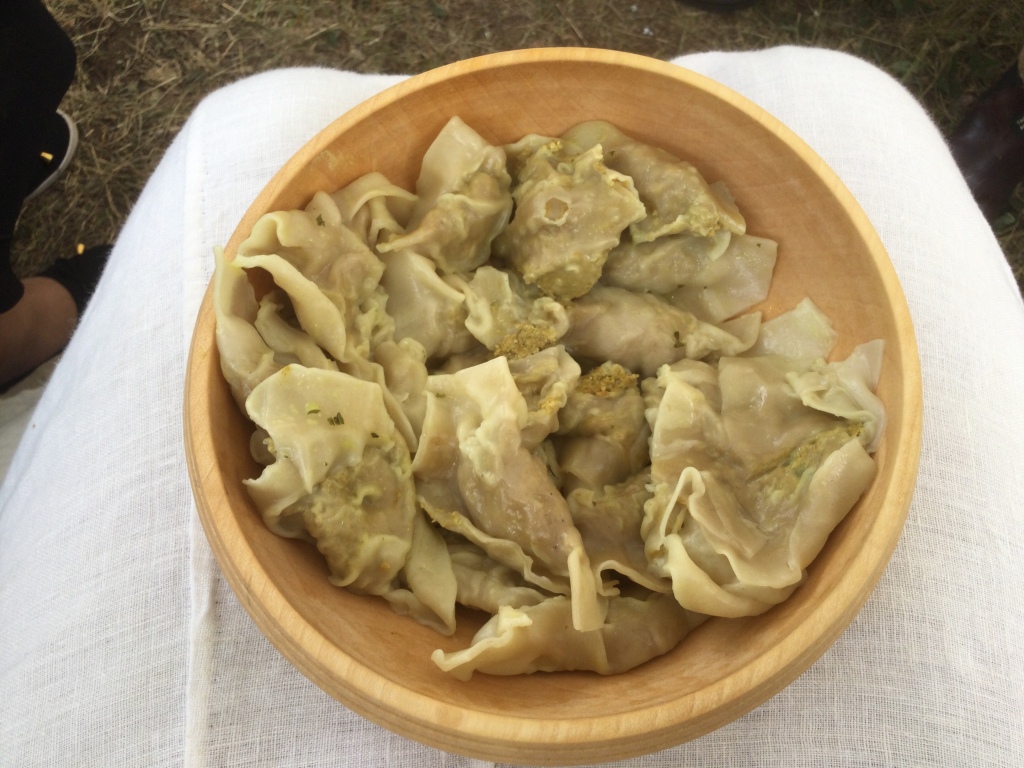My friend Dorothea of Holme hosted a dumpling session at War of the Trillium earlier this month, where we tried to define dumplings. To me, dumpling is most commonly the kind of food described when you look up the work “manti” in Wikipedia: a spiced meat mixture wrapped in a thin sheet of wheat dough which is then boiled or steamed. This type of dumpling is popular in most cuisines of Central Asia, Afghanistan, West Asia, South Caucasus, Turkey, the Balkans, Muslim parts of China, and the former Soviet countries (notably Ukraine and Georgia). The size and shape of dumplings (mantu/manti/pierogis/peteha/kinkhali vary significantly depending on geographic location.
Similar dumplings are found further east, known as jiaozi and baozi in China (and what we know as wontons or potstickers in Canada), mandu in Korea, buuz in Mongolia and momo in Tibet. This is where definitions of dumplings get confusing. There are also steamed bread-like buns called mantou in China, mandu in Korea, and manjū in Japan.
The earliest recipe I know of for manti was written by Muhammed bin Mahmud Shirvani in his 15th C manuscript adding to the earlier Arabic cookbook by al-Baghdadi. His is a steamed dumpling with a minced lamb and crushed chickpeas filling that is flavoured with cinnamon and vinegar and garnished with sumac. The manti would be served garlic-yoghurt sauce.
We also have Welserin’s recipe 193, which is what Dorothea made for us to try. Here is the recipe, taken from David Friedman’s site.
Going west, we have ravioli and tortelli in Italy (numerous recipes in various medieval and Renaissance cookbooks), but also ravieles in Form of Curye, rabels in the Innsbruck Manuscript and boiled krapfen in Sabrina Welserin’s cookbook. The rabel and krapfen recipes are very similar. The kreplach (dumplings served in a broth) of Ashkenaki Jewish cooking may have appeared at round the same time.
193 How to make chicken dumplings
Take the meat from two chickens. After it is cooked chop it finely, mix grated Parmesan cheese in with it and color it yellow and stir it together. You should also put mace and pepper into it. After that prepare a dough. Make a thin flat cake and put the above described filling on it and form it into a dumpling and join the two ends together. Cook it in broth as long as for hard- boiled eggs and serve it warm.

Mention of kreplach leads me to another category of dumpling, the version we associated most with that word in North America. These are the bread dumplings, Knödel or matzo type, balls of dough that are boiled in a broth, or top a stew. Volker offers several dumpling recipes of this type, and the blog Give it Forth also offers a meat dumpling as one for guissell and related recipes, plus one for juschelle of fish.
So what is not a dumpling? We considered empanadas, spring rolls and calzones, all foods with a dough exterior and a filling. We decided that they didn’t count if they were deep fried or baked as the primary cooking method. What about the dumpling-like toppings on apple pan dowdy or blueberry grunt? They are steamed/baked over a fruit base rather than with water or broth so probably not. Tamales? They are definitely steamed but they use a completely different starch (cornmeal) and retain their shape while cooking thanks to the banana leaf wrapper. We classified it as a “maybe”. These were our own arbitrary categories. There is no hard and fast definition, and others do count empanadas and spring rolls as dumplings.
All in all, it was a lively hour of discussion, punctuated with yummy treats.

